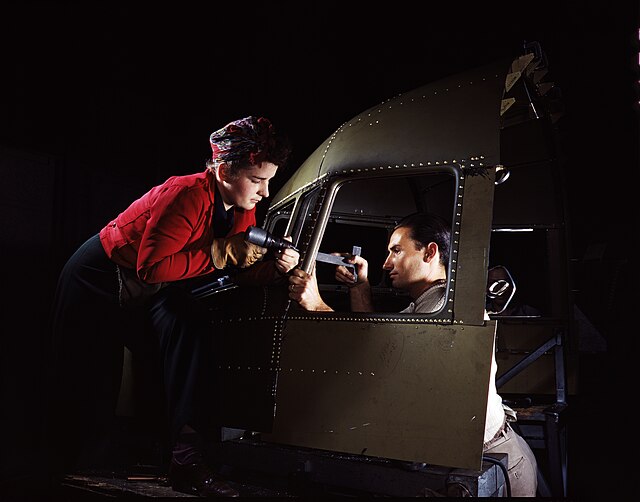Rosie the Riveter is an allegorical cultural icon in the United States who represents the women who worked in factories and shipyards during World War II, many of whom produced munitions and war supplies. These women sometimes took entirely new jobs replacing the male workers who joined the military. She is widely recognized in the "We Can Do It!" poster as a symbol of American feminism and women's economic advantage. Similar images of women war workers appeared in other countries such as Britain and Australia. The idea of Rosie the Riveter originated in a song written in 1942 by Redd Evans and John Jacob Loeb. Images of women workers were widespread in the media in formats such as government posters, and commercial advertising was heavily used by the government to encourage women to volunteer for wartime service in factories. Rosie the Riveter became the subject and title of a Hollywood film in 1944.
A "Rosie" putting rivets on an Vultee A-31 Vengeance in Nashville, Tennessee, in 1943
Women workers in the ordnance shops of Midvale Steel and Ordnance Company in Nicetown, Pennsylvania, during World War I (1918)
A woman operating a turret lathe (1942)
A man and woman riveting team working on the cockpit shell of a C-47 aircraft at the plant of North American Aviation (1942)
"We Can Do It!" is an American World War II wartime poster produced by J. Howard Miller in 1943 for Westinghouse Electric as an inspirational image to boost female worker morale.
J. Howard Miller's "We Can Do It!" poster from 1943
A propaganda poster from 1942 encouraging unity between labor and management of GM
Another poster by J. Howard Miller from the same series as "We Can Do It!"
An example of commercial use on a pair of vending machines for bottled water at a WWII Battleship Museum








